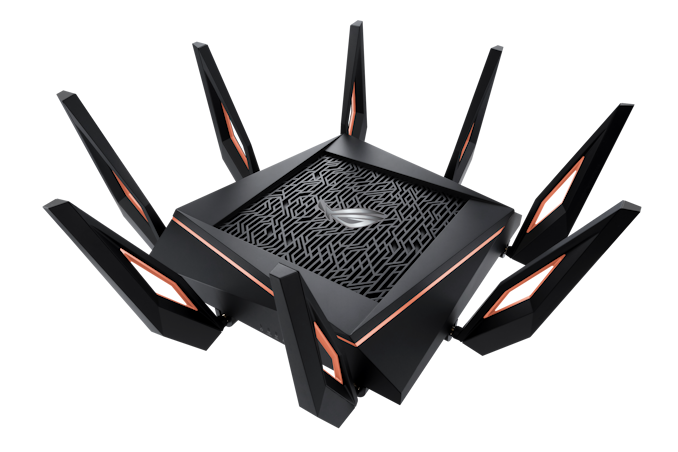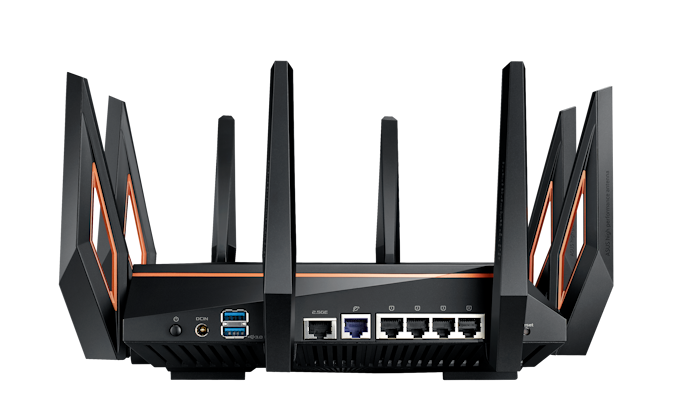AT 101: Wi-Fi 6 And Why You Want It
by Brett Howse on February 12, 2020 8:00 AM ESTThe 2020 AnandTech Wi-Fi Test Bed
We’ve been comfortably using Wi-Fi 5 for some time now, and it is only in the last several months that laptops have been shipping with Wi-Fi 6 based networking, mostly thanks to Intel’s Project Athena which has a requirement of the Intel AX200 Wi-Fi module, which is Intel's first Wi-Fi 6 based module on the market. Previously almost all shipping laptop computers offered Wi-Fi 5, and even a few with the latest Intel wireless adapters such as the Wireless-AC 9260 offered the advanced Wi-Fi 5 options such as 160 Mhz channel width, and MU-MIMO, so its nice to see a move to a new standard which includes these benefits across the board.
Although there are now quite a few Wi-Fi 6 routers and access points on the market, we had some specific criteria to meet. The router had to support Wi-Fi 6, and the 160 MHz channels, but because we are testing for performance, and not for capacity, we need an access point with a multi-Gigabit Ethernet connection. A typical laptop with a 2x2:2 network connection will be connecting to the access point at 2.4 Gbps, so transferring files from Ethernet over Gigabit will be a bottleneck. This does limit the selection somewhat.
After evaluating several models, we decided on the ASUS ROG Rapture GT-AX11000. The name is a mouthful, but meets all of our criteria and more. Most importantly, it offers the coveted 2.5 GbE port.
The ASUS ROG Rapture GT-AX11000
As the name implies, this router from ASUS can support up to 11000 Mbps over wireless, thanks to the 4x4 2.4 GHz, offering 1148 Mbps, and the two 4x4 5 GHz networks each offering 4804 Mbps. This adds up to just under 11000 Mbps, although with wireless the maximum connection speed is pretty much impossible to achieve. With the two separate 5 GHz networks, you can easily split off your consumption devices with higher priority devices, reducing interference on each network.
On the Wide Area Network (WAN) side there is a single 1 Gbps connection, and on the Local Area Network (LAN) side there are four 1 GbE and the single 2.5 GbE connection.
This router is built for capacity, with eight external antennae, and being a gaming router it also offers plenty of RGB lighting options. For those that don’t need the lighting, it can be turned off. ASUS also some tools to change the priority of gaming packets to reduce latency, assuming your network is that busy, and specifically prioritizes traffic from other ROG devices to make setup as easy as possible. ASUS even includes a utility to ping the various game servers for popular multiplayer games to provide you a map of latency to each one.
The GT-AX11000 also integrates with the ASUS AiMesh networking equipment to provide a whole-home mesh network, if even a router of this size can’t cover the entire house, either due to size or building materials blocking the signal.
For testing, the router is used in the access point mode, with the LAN connecting being over the 1 Gbps Ethernet, and a server connected directly to the router in the 2.5 Gbps port.













149 Comments
View All Comments
evilspoons - Wednesday, February 12, 2020 - link
Ubiquiti devices work as normal routers. You take your normal internet connection, wired ethernet coming out of your modem, and plug it into the WAN port of the Ubiquiti router.nathanddrews - Friday, February 14, 2020 - link
I run a custom pfSense router/firewall/gateway, so it would run as an AP only. It's incredible how terrible most consumer/prosumer routers are compared to a pfSense install on basic hardware.Xyler94 - Wednesday, February 12, 2020 - link
Most if not all?Most home routers don't have the interfaces to link directly into the feed, nor the proper security creds to get connections, but more often than not, their modem can be configured in Bridge Mode, which then the modem acts as the bridge between your network and the ISP network. The modem turns off all routing and NAT features, and basically hopes the router next to it does that work. I recently configured mine in Bridge Mode because I now have a Fortinet Firewall.
gobaers - Wednesday, February 12, 2020 - link
Yep, this. I refuse to allow the ISP to have a device on my internal network, they are and should remain dumb pipes.Makaveli - Wednesday, February 12, 2020 - link
I do this on Fiber.ISP provider modem/router is in the closet.
Router Asus AX88U using a Media converter.
Bell Canada uses GPON
So Fiber going directly into media converter then Ethernet from converter to Asus router and its runs great.
Dug - Wednesday, February 12, 2020 - link
OFDMA isn't necessarily broken, it's a compatibility issue though. This is from Tim on smbforums."But the larger problem appears to be compatibility problems with older legacy devices that have not had driver updates. Some devices don't understand the new information in beacon frames, so they either don't associate at all or don't stay associated.
There are more problems with 2.4 GHz devices than 5 GHz, but both bands have problems. Routers makers are very reluctant to enable OFDMA and break their customers' Wi-Fi."
So it looks as though OFDMA could work, but by doing so it may reduce the devices that can connect if you have older devices. I've seen this commented before from others that have done testing.
DanNeely - Wednesday, February 12, 2020 - link
If the issue is drivers for legacy devices, I suspect the only work around on time scales shorter than the next decade (or longer if some OEMs can save a penny/unit by using a crappy chipset that doesn't support it) will be to run 2 parallel 5/6 ghz wireless connections (one with and one without) similar to how we currently run both 2.4 and 5ghz service; one for the legacy devices that will never be updated and one for modern hardware.Whiteknight2020 - Wednesday, February 12, 2020 - link
Well, according to that link there are some that do, Asus ax88 for one (on 5ghz).Makaveli - Wednesday, February 12, 2020 - link
What is your definition of True OFDMA.The article you posted which I've already read since i'm a member of the SNB forum.
Shows its enabled on the AX88U but only on the 5Ghz. Which would be fine for me as I don't use 2.4ghz for anything.
Ryan Smith - Wednesday, February 12, 2020 - link
Funny enough, Asus just finally turned on OFDMA support in the GT-AX11000 in the latest firmware, which was released last month. So that landed just as we got the hardware.